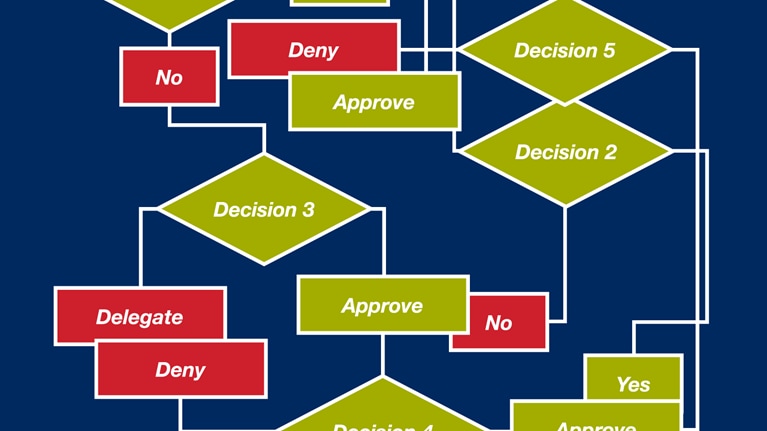Two years ago, we wrote about how it was simultaneously the best and worst of times for decision makers in senior management. Best because of more data, better analytics, and clearer understanding of how to mitigate the cognitive biases that often undermine corporate decision processes. Worst because organizational dynamics and digital decision-making dysfunctions were causing growing levels of frustration among senior leaders we knew.
Since then, we’ve conducted research to more clearly understand this balance, and the results have been disquieting. A survey we conducted recently with more than 1,200 managers across a range of global companies gave strong signs of growing levels of frustration with broken decision-making processes, with the slow pace of decision-making deliberations, and with the uneven quality of decision-making outcomes. Fewer than half of the survey respondents say that decisions are timely, and 61 percent say that at least half the time spent making them is ineffective. The opportunity costs of this are staggering: about 530,000 days of managers’ time potentially squandered each year for a typical Fortune 500 company, equivalent to some $250 million in wages annually.1
The reasons for the dissatisfaction are manifold: decision makers complain about everything from lack of real debate, convoluted processes, and an overreliance on consensus and death by committee, to unclear organizational roles, information overload (and the resulting inability to separate signal from noise), and company cultures that lack empowerment. One healthcare executive told us he sat through the same 90-minute proposal three times on separate committees because no one knew who was authorized to approve the decision. A pharma company hesitated so long over whether to pounce on an acquisition target that it lost the deal to a competitor. And a chemicals company CEO we know found himself devoting precious time to making hiring decisions four levels down the organization.
In our previous article, we proposed solutions that centered around categorizing decision types and organizing quite different processes against them. Our latest research confirms the importance of this approach, and it also highlights for each major decision category a noteworthy practice—sometimes stimulating debate, for example, while in other cases empowering employees—that can yield outsize improvements in effectiveness. When improvements in these areas are coupled with an organizational commitment to implement decisions—embracing not undercutting them—companies can achieve lasting improvements in both decision quality and speed. Indeed, faster decisions are often a happy outcome of these efforts. Our survey showed a strong correlation between quick decisions and good ones,2 suggesting that a commonly held assumption among executives—namely, “We can have good decisions or fast ones, but not both”—is flawed.
Three fixes that make a difference
Of the four decision categories we identified two years ago, three matter most to senior leaders. Big-bet decisions (such as a possible acquisition) are infrequent but high risk and have the potential to shape the future of the company; these are generally the domain of the top team and the board. Cross-cutting decisions (such as a pricing decision), which can be high risk, happen frequently and are made in cross-functional forums as part of a collaborative, end-to-end process. Delegated decisions are frequent but low risk and are effectively handled by an individual or working team, with limited input from others. (The fourth category, ad hoc decisions, which are infrequent and low stakes, is not addressed in this article.) Clearly, it is important that these types of decisions happen at the appropriate level of the company (CEOs, for example, shouldn’t make decisions that are best delegated). And yet, just as clearly, many decisions rise up much higher in the company than they should (see sidebar, “Avoiding life on the bubble”).
Even those businesses that do make decisions at the right level, however, complain about slow and bad outcomes. The evidence of our survey—and our experience watching executives grapple with this—suggests that while the best practices for making better decisions are interrelated, there’s nonetheless one standout practice that makes the biggest difference for each type of decision (exhibit).

Big bets—facilitate productive debate
Big-bet decisions can be future-shapers for a company, the most important decisions leaders make. And they often receive much less scrutiny than they should.
The dynamic inside many decision meetings doesn’t help. It’s as if there is an unspoken understanding that the meeting should proceed like a short, three-act play. In the first act, the proposal is delivered in a snappy PowerPoint presentation that summarizes the relevant information; in the second, a few tough yet perfunctory questions are asked of the presenter and answered well; in the final act, resolution arrives in the form of an undramatic “yes” that may seem preordained. Little substantive discussion takes place.
In a global agricultural company, for example, the members of the executive committee tended to speak up only if their particular area of the business was being discussed. The tacit assumption was that people wouldn’t intrude on colleagues’ area of responsibility. Consequently, when the top team moved to decide on a proposed new initiative in Europe, the leaders from the US business stayed silent, even though they had years of hard-won experience in marketing and cross-selling similar agricultural products to those new ones under discussion. Nonetheless, the decision was made, the products launched—and sales lagged expectations. Later, the European sales force was frustrated to learn their US counterparts had relevant experience that would have helped.
Whether the cause of such dynamics is siloed thinking or a consensus-driven culture (of which, more later), the effect on decision making is decidedly negative. Bet-the-company decisions require productive interactions and healthy debate that balance inquiry and advocacy. In fact, the presence of high-quality interactions and debate was the factor most predictive of whether a respondent in our survey also said their company made good, fast big-bet decisions.
Would you like to learn more about our People & Organizational Performance Practice?
Leaders can encourage debate by helping overcome the “conspiracy of approval” approach to group discussion. Simple behavior changes can help. For example, consider starting the decision meeting by reminding participants of the overall organizational goals the meeting supports, in order to reframe the subsequent discussions. Then assign someone to argue the case for, and against, a potential decision or the various options under consideration. Similarly, ask the leaders of business units, regions, or functions to examine the decision from outside their own point of view. A rotating devil’s advocate role can bolster critical thinking, while premortem exercises (in which you start by assuming the initiative in question turned out to be a failure, and then work back for likely explanations) can pressure test for weak spots in an argument or plan.3
The objective should be to explore assumptions and alternatives beyond what’s been presented and actively seek information that might disconfirm the group’s initial hypotheses. Creating a safe space for this is vital; at first it can be helpful for the most senior participants to ask questions instead of expressing opinions and to actively encourage dissenting views. Productive debate is essentially a form of conflict—a healthy form—so senior executives will need to devote time to building trust and giving permission to dissent, irrespective of the organizational hierarchy in the room.
A final note of caution: minimizing the number of debate participants to speed up decision making could harm decision quality. As many studies show, greater diversity brings greater collective wisdom and expertise, along with better performance. This is also true in decision making. To ensure a faster process, companies should manage the expectations of debate participants by limiting their voting rights and sticking to other agreed-upon processes, as we explore next.
Cross-cutting decisions—understand the power of process
An executive we know joked during a meeting that “a committee is born every day in this organization.” Just then, another executive nearby looked up from his computer to announce he had just been invited to join a new committee. The comedic timing of the line was perfect, but it wasn’t a joke.
Or perhaps the joke is on the rest of us? We often find companies maintaining a dozen or more senior-executive-level committees and related support committees, all of which recycle the same members in different configurations. The impetus for this is understandable—cross-cutting decisions, in particular, are the culmination of smaller decisions taking place elsewhere in the company. And cross-cutting decisions were the ones that executives in our survey had the most exposure to, regardless of their seniority.
Yet when it comes to cross-cutting decisions (involving, for example, pricing, sales, and operations planning processes or new-product launches), only 34 percent of respondents said that their organization made decisions that were both good and timely.
There are many reasons cross-cutting decisions go crosswise. Leaders may not have visibility on who is—or should be—involved; silos make it fiendishly hard to see how smaller decisions aggregate into bigger ones; there may be no process at all, or one that’s poorly understood.
Solving for cross-cutting decisions, therefore, starts with commitment to a well-coordinated process that helps clarify objectives, measures, targets, and roles. In practical terms, this might mean drawing a bright line between the portion of a meeting dedicated to decisions from the parts of a meeting meant to inform or discuss. Any recurring meetings (particularly topic-focused ones) where the nature of the decision isn’t clear are ripe for a rethink—and quite possibly for elimination.
Good meeting discipline is also a must. For example, a mining company realized that its poor decision making was related to the lack of rigor with which executives ran important meetings. As a result, the top team developed a “meeting manifesto” that spelled out required behaviors, starting with punctuality. The new rules also required leaders to clarify their decision rights in advance, and to be more deliberate about managing the number of participants so that meetings wouldn’t become bloated, on the one hand, or lack diverse views, on the other.
The manifesto was printed on laminated posters that were put in all meeting rooms, and when the CEO was seen personally reinforcing the new rules, the news spread quickly that there was a new game afoot. As the new practices took hold, the benefits became apparent. In pulse-check surveys conducted over the course of the following year, the company’s measures of meeting effectiveness and efficiency went up by almost 50 percent.
A social-network analysis, meanwhile, allowed a global consumer company to identify time wasting around decision making on a heroic scale—as many as 45 percent of interactions were found to be potentially inefficient, and 23 percent of the individuals involved in an average interaction added no value. In response, the company broke down complex processes into key decisions, clarified roles and responsibilities for each one, defined inputs and outputs for each process, and made one person accountable for each outcome. After conducting pilots in several countries, executives used two-day workshops to roll out the process redesign. The resulting benefits included a significant financial boost (as employees used the freed-up time in higher-value ways), as well as an arguably more important boost in employees’ morale and sense of work–life balance, which in turn has helped the company attract and retain talent.
Delegated decisions—make empowerment real
Delegated decisions are generally far narrower in scope than big-bet decisions or cross-cutting ones. They are frequent and relatively routine elements of day-to-day management. But given the multiplier effect, there is a lot of value at stake here, and when the organization’s approach is flawed it’s costly.
In our experience, ensuring that responsibility for delegated decisions is firmly in the hands of those closest to the work typically delivers faster, better, and more efficiently executed outcomes, while also enhancing engagement and accountability.
Our research supports this view. Survey respondents who report that employees at their company are empowered to make decisions and receive sufficient coaching from leaders were 3.2 times more likely than other respondents to also say their company’s delegated decisions were both high quality and speedy.
A vital aspect of empowerment, we find, involves creating an environment where employees can “fail safely.” For example, a European financial-services company we know started a series of monthly, after-work gatherings where leaders could meet over drinks to discuss failure stories and the lessons they’d learned from them. The meetings were purposely kept informal, but top management nonetheless established ground rules to ensure that the stories would be meaningful (not trivial) and that employees telling the stories would be protected. The meetings started small but became popular quickly. Today, a typical session includes 40 to 50 of the company’s top 150 leaders. The climate of trust and openness the sessions encourage has translated into better ideas, including practical lessons that have helped the company speed up its release of new products.

The case for behavioral strategy
As this example suggests, empowerment means not only giving employees a strong sense of ownership and accountability but also fostering a bias for action, especially in situations where time is of the essence. That’s easier said than done if there’s no penalty for avoiding a decision or sanction for escalating issues unnecessarily.
Executives who get delegated decisions right are clear about the boundaries of delegation (including what’s off-limits and how and where to escalate what’s beyond an individual’s competence), ensure that those they entrust with decision-making authority have the relevant skills and knowledge to act (and if not, provide them with the opportunity to acquire those capabilities), and explicitly make people accountable for their areas of decision-making responsibility (including spelling out the consequences for those who fail to respond to the challenge). This often means senior leaders engaging in conversations and dialogue, encouraging those newly empowered to seek help, and in the early days subtly and invisibly monitoring the performance of those participating in “delegated” forums so as not to appear to be taking over. Leaders might want to start mentoring their reports with a small “box” of accountability, slowly expanding it as more junior executives grow in confidence.
For leaders looking to become better delegators, it’s not a question of choosing between a style that is “hands-on” or “hands-off,” or between one that is “controlling” or “empowering.” There’s a balance to be struck. Root out micromanagers who are both hands-on and controlling, as well as “helicopter autocrats” who are hands-off and controlling, occasionally swooping in, barking orders, and disappearing again. But the laissez-faire executive—generally too hands-off, delegating but leaving those with the responsibility too much to their own devices (sometimes with disastrous results)—is also a danger. The ideal in our experience are hands-on and delegating leaders who coach, challenge, and inspire their reports, are there to help those who need help, and stay well clear of actually making the decision.
After the decision: Seek commitment, not unanimous agreement
In his April 2017 letter to Amazon shareholders, CEO Jeff Bezos introduced the concept of “disagree and commit” with respect to decision making. It’s good advice that often goes overlooked. Too frequently, executives charged with making decisions at the three levels discussed earlier leave the meeting assuming that once there’s been a show of hands—or nods of agreement—the job is done. Far from it.
Indeed, any agreement voiced in the absence of a strong sense of collective responsibility can prove ephemeral. This was true at a US-based global financial-services company, where a business-unit leader initially agreed during a committee meeting not to change the fee structure for a key product but later reversed course. The temptation was too great: the fee changes helped the leader’s own business unit—albeit ultimately at the expense of other units whose revenues were cannibalized.
One of the most important characteristics of a good decision is that it’s made in such a way that it will be fully and effectively implemented. That requires commitment, something that is not always straightforward in companies where consensus is a strong part of the culture (and key players acquiesce reluctantly) or after big-bet situations where the vigorous debate we recommended earlier has taken place. At a mining company, real commitment proved difficult because the culture valued “firefighting” behavior. In staff meetings, company executives would quickly agree to take on new tasks because it made them look good in front of the CEO, but they weren’t truly committed to following through. It was only when the leadership team changed this dynamic by focusing on follow-up, execution risks, and bandwidth constraints that execution improved.
While it’s important to devote enough resources to help propel follow-through, and it’s also important to assign accountability for getting things done to an individual or at most a small group of individuals, the biggest challenge is to foster an “all-in” culture that encourages everyone to pull together. That often means involving as many people as possible in the outcome—something that, paradoxically, in the end will enable the decision to be implemented more speedily.
Follow the value
There are many keys to better decision making, but in our experience focusing on the three practices discussed here—and on the commitment to implement decisions once taken—can reap early and substantial dividends. This presupposes, of course, that the decisions leaders make at all levels of the organization reflect the company’s strategy and its value-creation agenda. That may seem obvious, but it bears repeating because all too often it simply doesn’t happen. Take the manufacturing company whose operations managers, faced with calls from the sales team to raise production in response to anticipated customer demand, had to consider whether they should spend unbudgeted money on overtime and hiring extra staff. With their bonuses linked exclusively to cost targets, they faced a dilemma. If they took the decision to increase costs and new orders failed to materialize, their remuneration would suffer; if the sales team managed to win new business, the sales representatives would get the kudos, but the operations team would receive no additional credit and no additional reward. Not surprisingly, the operations managers, in their weekly planning meeting, opted not to take the risk, rejected a proposal to set up a new production line, and thereby hindered (albeit inadvertently) the group’s higher growth ambitions. This poor-quality—and in our view avoidable—outcome was the direct result of siloed thinking and a set of narrow incentives in conflict with the group’s broader strategy and value-creation agenda. The underlying management challenge is part of a dynamic we see repeated again and again: when senior executives fail to explore—and then explain—the context and underlying strategic intentions associated with various targets and directives they set, they make unintended consequences inevitable. Worse, the lack of clarity makes it very difficult for colleagues further down in the organization to use their judgment to see past the silos and remedy the situation.
Designing an organization to deliver its strategic objectives—setting a clear mission, aligning incentives—is a big topic and outside the scope of this article. But if different functions and teams do not feel a connection to the bigger picture, the likelihood of executives making good decisions, whether or not they adopt the ideas discussed earlier, is significantly diminished.


